Fight Game: Rivals - Review
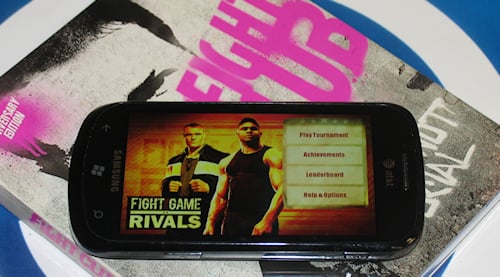
The last few years have seen a revival of the fighting game genre, thanks in no small part to Capcom’s Street Fighter IV. That game even made the trip to iPhone intact, with simplified touch screen controls keeping the portable version fun and playable. Since Street Fighter IV hasn’t been ported to Windows Phone yet, the platform is wide open for a fighter.
Enter Fight Game: Rivals from Dutch developer Khaeon GameStudio. Rivals takes an entirely different approach to touch-screen fighting, replacing a virtual stick and buttons with turn-based strategy and minigames. It’s a clever approach, though the gameplay itself lacks variety.
Jump kick past the break for our full review.
No frills
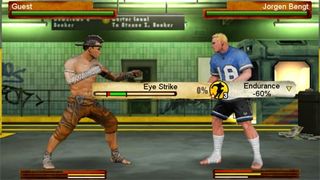
Fight Game: Rivals may contain the word ‘rivals’ in its title, but there is no actual rivalry or story in the game. Giving each character a rival and some between-fight dialogue would have spiced things up a bit. Instead, Rivals simply encompasses a series of 9 tournaments, each consisting of three or four fights, for a total of 29 battles. All of the tournament combatants are variations of the six playable fighters but with different names and outfits, except for the two bosses.
The fighters
Playable characters include:
Get the Windows Central Newsletter
All the latest news, reviews, and guides for Windows and Xbox diehards.
- Manuel Rojas a capoeira fighter from Brazil
- Darnel Jackson, an American boxer
- Han Po Hing, a kung fu master from China
- William Walker, an American wrestler and figure-skating champion (just kidding)
- Halsten Nordlund, a Swedish fish, I mean kickboxer
- Jao Thawan, a Muay Thai expert from Thailand
When I first saw live-action photographs of the game’s two non-playable bosses, Semmy Schilt and Alistair Overeem, I thought they were just burly dudes paid to pose by the developer. As it turns out, they’re actual Dutch martial arts champions.
Use skills to pay the bills
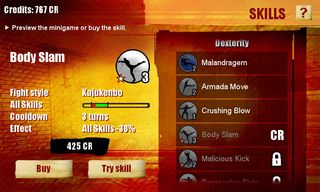
Fight Game: Rivals has a rather unique combat system; thankfully it also includes an excellent tutorial and help text. Before each fight, players select five skills to bring into battle. Skills can be either attacks or buffs. Fighters can only choose from a few skills at the outset, but more become purchasable through tournament progress.
Skills come in two basic types: attacks and buffs. Each skill falls into one of three classes, or attributes: Strength (red), Dexterity (white), and Endurance (yellow). Classes strongly influence the effectiveness of skills. For instance, if an opponent’s Dexterity is much lower than yours, a Dexterity-type attack will do extra damage against him. Classes might be difficult to keep up with, but the game makes it easy by displaying how effective each skill will be before you choose it.
Some attacks, known as Power Attacks, not only damage the enemy’s health, they also lower one or more of his stats for one turn. Thus it’s possible to say, reduce the guy’s strength, and then capitalize on it by using a strength-class attack the next turn. Buffs work in a similar fashion, raising stats instead of lowering them.
How to hurt other people
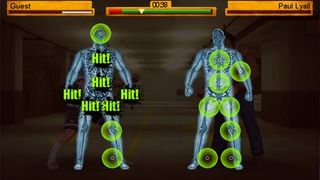
Working the class percentages isn’t all it takes to win a fight. Each attack has a certain range of damage it can do, displayed beforehand on a green line. The wider the line, the greater variation in potential damage – and the presence of red next to the green means that failing the attack will result in no damage dealt.
Timing minigames are the key to delivering attacks effectively. After selecting a move, one or two skeletons appear on screen. The player must tap green circles as they appear over pressure points on the skeleton. Miss too many or hit too many red circles by mistake and the move won’t deal as much damage to the opponent, if any. But hit a lot of the circles and you can watch as your fighter unleashes a powerful combo. Powerful skills have more challenging minigames, creating a good risk and reward mechanic. Thankfully every skill’s minigame can be practiced outside of battle.
Blocking and buffs
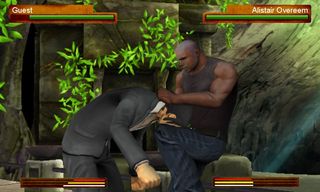
Of course, fighting is a two-way street. Any attack you do may be blocked by the opponent and vice versa. Blocking works by performing the same minigame that pulls off a move. Succeed at the minigame and you’ll take less damage from enemy attacks. Depending on the fighters’ stats and the class of the attack, you may even be able to counter the opponent’s move and damage him during his own turn. Once the other guy runs out of health, he plops to the ground and you win. Don’t feel bad – he probably had it coming.
Buffs use an entirely different minigame than attacks. Players must defend a half-circle (situated near the bottom of the screen) from a series of incoming objects by blocking them with a shield. A slider controls the shield’s rotation. While the buff minigame isn’t too challenging, the slider control is kind of unresponsive, sapping the fun a bit.
Too much of a good thing, too little of others
Fight Game has a fun battling mechanic, but that’s really all it has. The game is essentially an RPG with no story or exploration – just the battles. Think to yourself for a moment whether an RPG made up of 100% combat will stay fresh for very long... Rivals’ battles actually did keep me engrossed for my first playthrough, which lasted about three hours. You’re supposed to beat the game with all six characters, though, wherein the problems commence.
Every character plays almost exactly the same, just with different stats and a different selection of moves. But the moves here aren’t like those in a true fighting game – they blend together as they all involve slight variations of the same two minigames. If each character’s moves used entirely different minigames, then perhaps the gameplay could have sustained the entire title. But as it stands, Rivals just suffers from too much repetition. Not everyone will mind this – Twin Blades has it fans despite its extreme repetitiveness, after all.
Graphics and sound
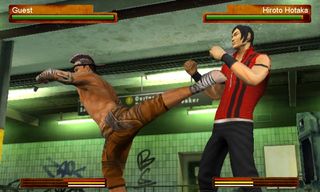
Artistically, Fight Game: Rivals doesn’t flaunt a lot of personality. The characters designs and locales are realistic but highly generic. Still, the game’s 3D graphics are fairly impressive. Characters and backgrounds alike are 3D and show a lot of detail for a mobile game. Movement is smooth and appears to be motion captured, though every character shares the same goofy victory animation. You can even pan the camera around during fights. So while I would have liked some stylization and flair ala Street Fighter IV, this graphics engine is no slouch.
The area where Rivals fails the timing minigame, so to speak, is sound. The music, of which I only noticed two different tunes (not even a dramatic boss theme!) is screechy and annoying. After my first playthrough I just turned it off. Sound effects are far less annoying, with a catchy effect that plays when you hit a green circle during minigames. Rivals could use a different, more rewarding sound when pulling off a minigame perfectly though. Khaeon could take a note from PopCap’s sound design philosophy. Oh, and the fighters themselves remain completely silent, even when taking a beating. Surely a few grunts and groans wouldn’t have been too costly to record.
Achievements
Gamers will unlock 17 of Fight Game: Rivals’ 20 Achievements in their first playthrough of the game, which should take two or three hours. The rest are for playing the game for 10 days in a row (ehhh), unlocking all skills with all fighters (which you'll get near the end of the tournaments), and completing all tournaments with all fighters. Beating it with everybody will take several hours, but the game’s too light on content to stretch it out that far. Thus every subsequent playthrough after the first is quite a grind.
Overall Impression
Apparently Khaeon plans to make Fight Game a franchise. In that case, Rivals is promising start. The turn-based fighting is highly original. It doesn’t have the same inherent variety and excitement of a traditional fighting game, but at least it’s creative and well-executed. Still, a great fighting mechanic needs a good game to be built around it, and that’s where Rivals fails to qualify.
If each character had their own story, or there was something more to do than just picking moves and executing the same handful of minigames over and over and over, this would be an easy recommendation. Maybe those things will come with the sequel. For now, the smart bet is to try the demo and determine whether you have the patience to stick with Rivals for the 10-12 hours it will take to master each character. Martial arts are supposed to teach perseverance after all…
Fight Game: Rivals costs $2.99 and there is a free trial. Procure it here (Zune link) on the Marketplace.
Paul Acevedo is the Games Editor at Windows Central. A lifelong gamer, he has written about videogames for over 15 years and reviewed over 350 games for our site. Follow him on Twitter @PaulRAcevedo. Don’t hate. Appreciate!
